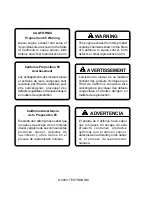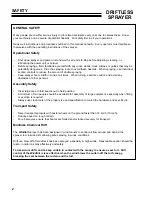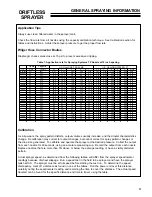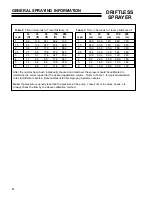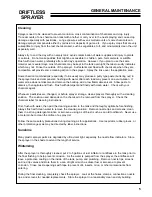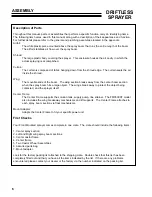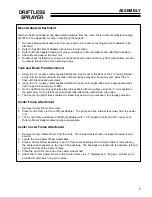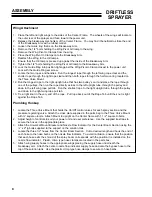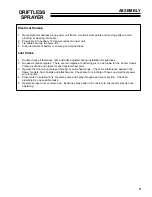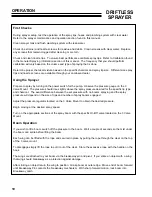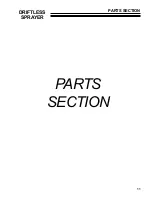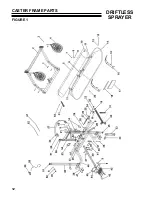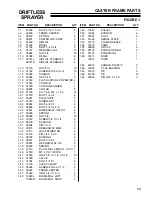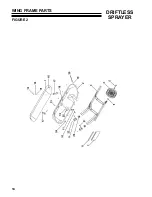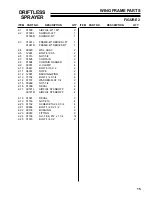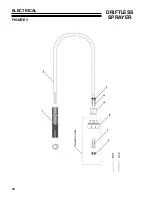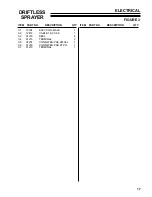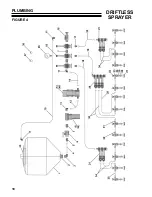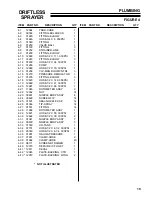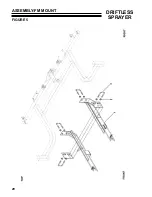
5
DRIFTLESS
SPRAYER
GENERAL MAINTENANCE
Cleaning
Sprayers need to be cleaned to prevent corrosion, cross contamination of chemicals and crop injury.
Trace amounts of one chemical can react with another or carry over to the next spraying and cause crop
damage, especially with pesticides. Long exposures with even small amounts of some chemicals can
damage sprayer components either by corrosion or deposits of gums, etc. If you spray crops that are very
susceptible to injury from the last chemical used, such as vegetables, turf, and ornamentals clean the unit
especially well.
Always try to end the day with an empty tank; avoid contamination of water supplies and injury to plants
or animals. Do not make puddles that might be accessible to children, pets, farm animals, or wildlife.
Flush with clean water, preferably after each day’s operation. However, if you plan to use the same
material over several days, most chemicals may be kept in the tank overnight; the label usually indicates
which may not. Rinse the outside of the sprayer. Surfactants combined with chemicals, when they are
compatible, will provide some cleaning action in the sprayer. Spray the rinse over the application area.
Some chemical combinations (especially if oil is used) may produce a putty type paste (buttering out) in
the sprayer tank and components; flushing with water after each load may prevent an accumulation. If
water alone does not dissolve and remove the buildup, add a low flammable solvent. Allow paste to
dissolve, then agitate and flush. Flush with detergent and finally with clean water. Check with your
chemical agent.
Whenever pesticides are changed, or before sprayer storage, clean sprayers thoroughly with a cleaning
solution. The solution used depends on the chemical to be removed from the sprayer. Check the
chemical label for cleaning instructions.
First, flush with water, then add the cleaning solution to the tank and thoroughly agitate before flushing.
Always flush with clean water to remove the cleaning solution. Remove nozzle tips and screens; clean
them in a strong detergent solution or kerosene, using a soft brush such as an old toothbrush. Never use
a metal probe to clean the orifice of a spray tip!
Follow the same safety precautions during cleaning as for applications. Use respirator, rubber gloves, or
other protective gear as may be directed by label instructions.
Sunshine
Many plastic sprayer parts are degraded by ultra violet light, especially the nozzle flow indicators. Store
the sprayer in the shade to extend the length of service.
Winterizing
After the sprayer is thoroughly cleaned, put 2 to 5 gallons of rust inhibitor or antifreeze in the tank prior to
the final flushing to help prevent corrosion. As the water is pumped from the sprayer, the antifreeze will
leave a protective coating on the inside of the tank, pump, and plumbing. Remove nozzle tips, screens
and no drip valves and store them in a can of light oil such as diesel fuel or kerosene to prevent
corrosion. Close nozzle openings with tape to prevent dirt, insects, mice, or other contaminants from
entering.
During the final cleaning, completely check the sprayer. Look at the hoses, clamps, connections, nozzle
tips, and screens for needed replacements. Store the sprayer in a reasonably clean and dry building.
Summary of Contents for 73-70675
Page 13: ...11 DRIFTLESS SPRAYER PARTS SECTION PARTS SECTION...
Page 14: ...12 DRIFTLESS SPRAYER CASTER FRAME PARTS FIGURE 1...
Page 16: ...14 DRIFTLESS SPRAYER WING FRAME PARTS FIGURE 2...
Page 18: ...16 DRIFTLESS SPRAYER ELECTRICAL FIGURE 3...
Page 20: ...18 DRIFTLESS SPRAYER PLUMBING FIGURE 4...
Page 22: ...20 DRIFTLESS SPRAYER ASSEMBLY FM MOUNT FIGURE 5...
Page 24: ...22 DRIFTLESS SPRAYER INSTALLATION SHEET FIGURE 6...
Page 26: ...24 DRIFTLESS SPRAYER CASTER WHEEL ASSEMBLY FIGURE 7...


